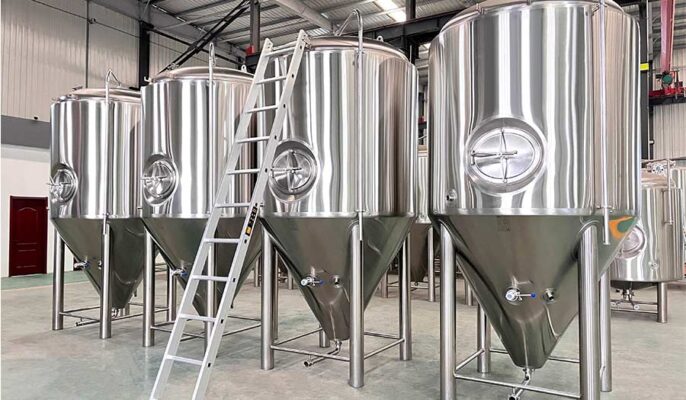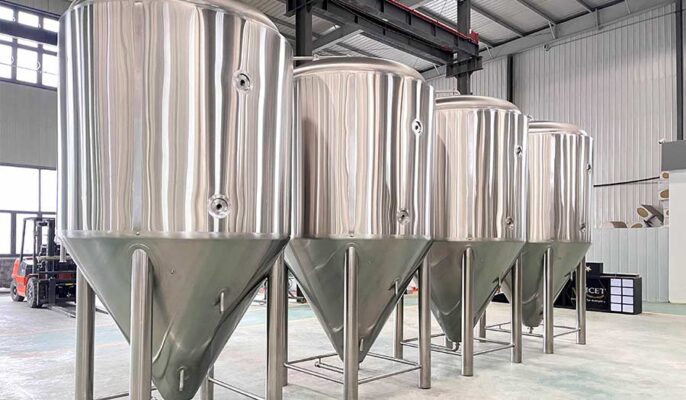Los recipientes de fermentación, llamados fermentadores o FV, son de muchos tipos y materiales. Tanques de fermentación son equipos esenciales para las fábricas de cerveza. Un fermentador es un recipiente que contiene un sustrato, como mosto o zumo de uva, para la fermentación. Estos depósitos proporcionan el entorno necesario para que la levadura u otros microorganismos conviertan el azúcar en alcohol y dióxido de carbono.
Diferentes tipos de tanques de fermentación
Depósito de fermentación de madera
Los barriles de madera no son los recipientes de fermentación más antiguos. Consiste en introducir el mosto en un barril con la combinación de levadura que se prefiera. La cerveza producida mediante este proceso no debe confundirse con la cerveza de barril, que se fermenta en tanques separados y luego envejece en barriles.
La cerveza fermentada en barrica tiene la ventaja de la novedad y puede transmitir a la cerveza algunas de las cualidades de sabor presentes en la madera de la barrica. Pero puede ser difícil de crear y los elaboradores suelen tener un control limitado sobre ella. Esto hace que elaborar una cerveza consistente sea todo un reto.
Tanque de fermentación de plástico
Los fermentadores de plástico, también conocidos como bombonas, son una opción barata para las cervecerías artesanales, a menudo utilizados para lotes a pequeña escala o experimentales. Fabricados con plástico apto para uso alimentario, como PET o HDPE, estos depósitos son ligeros y fáciles de transportar.
Una de las ventajas de utilizar fermentadores de plástico es que son baratos en comparación con otras opciones y pueden sustituirse si se dañan. También son fáciles de limpiar y pueden equiparse con esclusas para liberar gases durante la fermentación. Pero los tanques de fermentación de plástico no son tan duraderos como los de acero inoxidable o madera y no son adecuados para el envejecimiento a largo plazo de la cerveza.
Tanque de fermentación de cerámica
Los fermentadores de cerámica, también conocidos como ánforas, son una opción más tradicional para las cervecerías artesanales, a menudo utilizados para producir cervezas antiguas y exóticas. Fabricadas en cerámica, estas jarras son conocidas por su capacidad para conservar el calor, lo que resulta útil durante el proceso de fermentación.
Una de las ventajas de utilizar fermentadores de cerámica es que son porosos, lo que permite que la cerveza respire y absorba oxígeno durante la fermentación. Esto ayuda a desarrollar sabores y aromas complejos en el producto final. Los fermentadores de cerámica también son atractivos y pueden añadir un toque único a la imagen de marca de una cervecería. Pero son frágiles y propensos a romperse, y su naturaleza porosa también los hace más susceptibles a la contaminación si no se limpian y desinfectan.
Tanque de fermentación de hormigón
Los fermentadores de hormigón son una nueva adición a la escena de la cerveza artesana, a menudo utilizados para producir estilos modernos y experimentales de cerveza. Fabricados en hormigón, estos depósitos son conocidos por su capacidad para conservar el calor y sus propiedades aislantes, muy útiles durante el proceso de fermentación.
Una de las ventajas de utilizar cubas de fermentación de hormigón es que son muy duraderas y pueden soportar los cambios de presión y temperatura que se producen durante el proceso de fermentación. También son resistentes a la corrosión y fáciles de limpiar, lo que los convierte en una opción higiénica para las fábricas de cerveza. Sin embargo, los fermentadores de hormigón son caros de fabricar e instalar y requieren equipos y conocimientos especializados para su manejo.
Depósito de fermentación de acero inoxidable
Los fermentadores de acero inoxidable son la opción más popular para las cervecerías artesanales debido a su durabilidad y versatilidad. Estos depósitos están fabricados en acero inoxidable de alta calidad y pueden soportar los cambios de presión y temperatura que se producen durante la fermentación. También son resistentes a la corrosión y fáciles de limpiar, lo que los convierte en una opción higiénica para las fábricas de cerveza.
Una de las ventajas de utilizar fermentadores de acero inoxidable es que pueden utilizarse tanto para la fermentación primaria como para la secundaria. La fermentación primaria es la fase inicial de la fermentación, en la que se produce la mayor parte de la fermentación, mientras que la fermentación secundaria es la segunda fase de la fermentación y ayuda a clarificar y estabilizar la cerveza. Los tanques de acero inoxidable también pueden equiparse con sistemas de control de temperatura, lo que permite a las cervecerías controlar la temperatura del proceso de fermentación.

Tanque de fermentación tipos para distintos fines
Tanque de fermentación abierto
Los fermentadores abiertos son recipientes simples sin tapas ni sellos y son el tipo de fermentador más básico. Se utilizan para fermentar vino porque permiten un fácil acceso y prensado manual del sombrero (la capa de pieles y semillas de uva que suben a la superficie durante la fermentación).
Tanque de fermentación cerrado
Los fermentadores cerrados tienen una tapa sellada que evita que cualquier contaminante externo entre en el proceso de fermentación. Se utilizan en la elaboración de cerveza porque protegen el líquido de la exposición al aire, que puede provocar deterioro o sabores desagradables.
Tanque de fermentación de capacidad variable
Los fermentadores de capacidad variable tienen tapas flotantes y volúmenes ajustables, lo que los hace adecuados para fermentar diferentes cantidades de líquido. Son populares entre los cerveceros caseros y los pequeños cerveceros porque ofrecen flexibilidad y ayudan a reducir la cantidad de contacto del aire con el líquido fermentador.
Función del tanque de fermentación
- Regulación de la temperatura: Muchos fermentadores, especialmente los cerrados, están equipados con sistemas de control de la temperatura. Mantener la temperatura correcta es fundamental y afecta al perfil de sabor y a la calidad del producto final.
- Agitar y mezclar: Algunos fermentadores incorporan agitadores. Una mezcla adecuada garantiza una fermentación uniforme y un mejor control de la temperatura, y puede mejorar la salud de la levadura, especialmente en depósitos grandes.
- Entorno sellado: Protege los productos fermentados de contaminantes externos como levaduras salvajes y bacterias.
- Separación de sedimentos: El tanque de fermentación cónico permite que la levadura y otros sedimentos se depositen en el fondo. Este diseño simplifica el proceso de eliminación y hace más eficientes las siguientes etapas de filtración o trasiego.
Tipos de cubas de fermentación de acero inoxidable
Tanque cónico de fermentación
Los fermentadores cónicos tienen un fondo cónico que permite que los sedimentos se acumulen en el fondo. También tienen una válvula en el fondo para trasvasar la cerveza a otro recipiente. Estos fermentadores son ideales para quienes desean evitar el trasvase de cerveza con sedimentos. Los fermentadores cónicos también son ideales para el dry hopping o para añadir fruta durante la fermentación.
Depósito de fermentación de fondo plano
Los fermentadores de fondo plano tienen un fondo plano y suelen ser más baratos que los fermentadores cónicos. También son más fáciles de limpiar y desinfectar. Pero no ofrecen el mismo nivel de recogida de sedimentos que los fermentadores cónicos.
Los fermentadores de fondo plano son ideales para quienes no tienen que preocuparse por los sedimentos y no quieren gastar demasiado dinero. También son una buena opción para quienes desean un proceso de fermentación más sencillo.
Tanque de fermentación encamisado
Los fermentadores encamisados presentan un diseño de doble pared con una camisa exterior para controlar la temperatura durante el proceso de fermentación. Son ideales para elaborar cerveza u otras cervezas que necesiten un control preciso de la temperatura.
Los fermentadores encamisados también son ideales para quienes desean experimentar con distintas temperaturas durante el proceso de fermentación. Pueden utilizarse tanto para fermentaciones en frío como en caliente, lo que flexibiliza el proceso de elaboración.
Tanque de fermentación Unitank
Los fermentadores Unitank combinan las características de los fermentadores cónicos y los fermentadores encamisados. Tienen un fondo cónico y una camisa para controlar la temperatura. También incorporan una válvula de alivio de presión, perfecta para quienes deseen carbonatar la cerveza en el mismo recipiente.
Los fermentadores unitank son más caros que otros tipos de fermentadores, pero ofrecen un proceso de fermentación más avanzado y versátil. Son ideales para cerveceros profesionales que desean producir cerveza de alta calidad y tener un mayor control sobre el proceso.

¿Cómo elegir el fermentador adecuado?
- Tamaño y capacidad: Tenga en cuenta la cantidad de fermentación que pretende realizar. En el caso de las empresas comerciales, calcular la expansión futura también puede ayudar a determinar el tamaño del depósito.
- Material: La mayoría de los tanques de fermentación están hechos de acero inoxidable porque son duraderos, resistentes a la corrosión y fáciles de limpiar. Pero algunos métodos de fermentación tradicionales pueden utilizar madera u otros materiales.
- Control de la temperatura: Para muchos productos fermentables, es fundamental mantener temperaturas precisas. Los sistemas integrados de control de la temperatura pueden satisfacer estos requisitos.
En el mundo de la fermentación, el equipo que elija desempeña un papel clave a la hora de determinar la calidad de su producto final. A la hora de elegir un fabricante, tenga en cuenta no sólo el precio, sino también factores como la asistencia posventa, la garantía y la disponibilidad de piezas de repuesto. A lo largo de los años, los equipos de elaboración de cerveza micet también han ido muy por delante. Esto no sólo garantiza un producto de alta calidad, sino que también puede personalizarse para satisfacer las especificaciones exactas del cliente.




